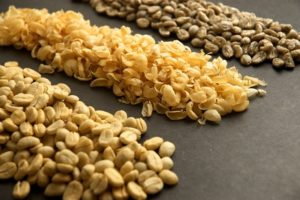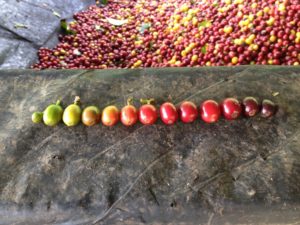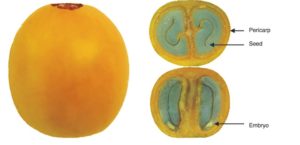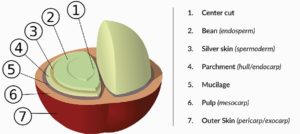Your favorite morning beverage begins nestled in the middle of vibrant red cherries. It takes nearly a year for a cherry to mature after first flowering, and about 5 years of growth for a coffee tree to reach full fruit production. With the exception of Peaberry, most coffee cherries contain two beans. Peaberry accounts for about 5% of the world’s coffee, has only a single bean inside the cherry, and is a natural mutation. Most coffee cherries contain two beans. Before it gets to be an aromatic, brown coffee bean, a coffee cherry’s many layers are shed. Attention to detail and skill are needed at each step to make the most of every bean. Perhaps the single most important factor in determining coffee quality is the care taken during post-harvest processing. A single mistake can have serious implications, at times, capable of spoiling an entire batch of coffee.
We invite you to take a look inside the anatomy of a coffee bean.

Parchment or endocarp–The endocarp, or parchment, is the innermost layer of the pericarp and is the hull that envelops the coffee bean. It is formed of three to seven layers of sclerenchyma cells (fibrous cells that serve as the principal support cells in plants). The cells of the endocarp harden during coffee fruit maturation, thus limiting the final size of the coffee seed, or bean. In arabica coffee, the average weight of the parchment with 11% moisture content is around 3.8% of total coffee fruit weight (Wilbaux, 1961, as cited in Borém, 2008).
Mucilage or mesocarp–The mesocarp, also referred to as the mucilage, is the flesh of the coffee fruit. While “pulp” can sometimes refer to solely the mesocarp, the term usually refers to a combination of the exocarp and part of the mesocarp removed during pulping. Flesh of the coffee fruit- during cherry maturation contains pectolytic enzymes which break down pectic chains, resulting in an insoluble hydrogel that is rich in sugars and pectins (Borem, 2008). This layer is left on to dry for our Semi-Washed process.

Silver Skin–The silver skin, also called the perisperm or spermoderm, is the outermost layer that wraps the seed. It is formed from the nucellus, or central portion, of the ovule. Generally some remnants of the silver skin remain on the bean pre-roast, and come off during coffee roasting as chaff. The silver skin may be polished off of the bean; however, it is generally accepted that this diminishes coffee flavor. It has also been proposed that the presence of a large amount of silver skin on milled coffee is a sign of coffee picked before its ideal ripeness. In some regions the silver skin may take on a darker hue, in which case the beans are called fox beans. Fox beans are not considered to be a defect.
Endosperm–The endosperm is the principal reserve tissue of the seed, and is composed of only one tissue, though the cells in the exterior and interior portion of the endosperm vary in oil content and cell wall thickness. The chemical content of the endosperm is of utmost importance since it is the precursor to the flavor and aroma of roasted coffee. The chemical compounds found in the endosperm can be classifed as soluble or insoluble in water. The water-soluble compounds are caffeine, trigonelline, nicotinic acid (niacin), at least 18 chlorogenic acids, mono-, di-, and oligosaccharides, some proteins and minerals, and carboxylic acids. Components insoluble in water include cellulose, polysaccharides, lignin, and hemicullulose, as well as some proteins, minerals, and lipids (Borem, 2008).

Many factors influence the taste of your coffee before it’s roasted such as farming practices (Who grew your coffee?), origin (Where was it grown?) and processing. At any step, if the quality is compromised, the coffee’s taste will be altered.

We hope this helps you understand the remarkable complexity of that special beloved little bean we know as coffee.
Borem, F. ed. Pos-colheita do cafe. Lavras: Editora UFLA, 2008.
Castro, R. & Marraccini, P. “Cytology, biochemistry and molecular changes during coffee fruit development.” Brazilian Journal of Plant Physiology, vol. 18, Jan – Mar 2006.
Wintgens, J. N. Coffee: Growing, Processing, Sunstainable Production (2nd ed.). Weinhem: Wiley-VCH, 2009.


